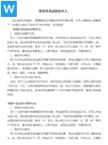







26个字母单词表
以下是一个包含26个字母的单词表,按照字母顺序排列:1. Aardvark2. Alphabet3. Banana4. Carrot5. Dolphin6. Elephant7. Falcon8. Giraffe9. Horse10. Ice11. Jaguar12. Kangaroo13. Lion14. Monkey15. Night16. Owl17. Penguin18. Quokka19. Rabbit20. Snake21. Tiger22. Unicorn23. Vulture24. Walrus25. Xerus26. Yak这个列表包含了一些具有代表性的单词,但是请注意,每个单词不一定都有实际的含义或者在日常生活中被广泛使用。这个列表主要体现了字母的顺序。
1. Aardvark: Aardvarks are large, burrowing mammals native to Africa. They are known for their long snouts which they use to dig for insects, their main food source. Outsource: The unusual name of this animal likely comes from the Afrikaans word "aarde," which means "earth," referring to the aardvark's habit of digging through the ground. Example: "The aardvark ventured out at dusk to forage for termites, its long snout sniffing out the ant hills in the dry, sandy soil."2. Alphabet: An alphabet is a set of letters or symbols that are used to form words and sentences in a particular language. Outsource: The concept of an alphabet originated from the Phoenician alphabet, which was developed in the 2nd millennium BC. Example: "The school child studied the alphabet, learning each letter and its corresponding sound."3. Banana: Bananas are a type of tropical fruit, known for their curved shape and yellow skin. They are often used in baking, smoothies, and as a snack. Outsource: The banana is native to Southeast Asia, and was cultivated in ancient China. Example: "She added a sliced banana to her smoothie for a sweet, creamy texture."4. Carrot: Carrots are a root vegetable with a sweet, earthy flavor. They are typically orange, but can also be found in purple, white, and red varieties. Outsource: Carrots are mentioned in the Bible, and were known in Europe as early as the 16th century. Example: "The children enjoyed dipping their sliced carrots into the creamy dip."5. Dolphin: Dolphins are intelligent, aquatic mammals known for their playful behavior and distinctive shapes. They are found in oceans and rivers worldwide. Outsource: The name "dolphin" likely comes from the Old Norse word "dolfin," meaning "fin." Example: "The dolphin breached the water surface with a splash, delighting the onlookers."6. Elephant: Elephants are the largest living land animals. They are known for their distinctive large ears and trunks, which are used for a variety of tasks like breathing, smelling, and grasping. Outsource: The word "elephant" comes from the Greek word "elephas," meaning "ivory." Example: "The baby elephant used its trunk to play with a ball, demonstrating its remarkable dexterity."7. Falcon: Falcons are birds of prey known for their speed and hunting prowess. They are often depicted in stories and myths. Outsource: Falcons have been admired for their hunting abilities for centuries, with some cultures believing them to have magical powers. Example: "The falcon swooped down to catch the mouse, showcasing its incredible agility."8. Giraffe: Giraffes are the tallest land animals, known for their long necks and spotted coats. They are herbivores, feeding on leaves and fruits. Outsource: The giraffe is named for the long, lanky body, likely coming from the French word "girafe." Example: "The giraffe used its long neck to reach the leaves high in the tree."9. Horse: Horses are large, domesticated mammals, known for their speed and strength. They have been used for transportation, labor, and sport for thousands of years. Outsource: The horse is one of the oldest domesticated animals, with evidence of early domestication dating back to the Neolithic period. Example: "The horse galloped across the field, its hooves pounding the earth."10. Ice: Ice is a frozen form of water, usually occurring at temperatures below freezing. It has various uses, from art to industry. Outsource: Ice has been used for cooling and storage for thousands of years, and is an essential part of many cultures' diets. Example: "The ice sculpture artist used chisels to carve intricate designs into the solid ice."11. Jaguar: Jaguars are large cats native to the Americas, known for their distinctive black spots and powerful build. They are skilled hunters of medium-sized mammals. Outsource: Jaguars have been depicted in art and mythology for thousands of years, with some cultures believing them to have supernatural powers. Example: "The jaguar stalked its prey through the dense forest, its powerful legs propelling it forward."12. Kangaroo: Kangaroos are marsupials native to Australia, known for their powerful hind legs which they use for jumping. They are herbivores, feeding on grasses and leaves. Outsource: Kangaroos are one of the unique and iconic animals of Australia, featured in the country's coat of arms. Example: "The kangaroo hopped across the sandy plain, using its long tail for balance."13. Lion: Lions are large cats, known for their manes and social behavior. They are the only big cats that live in groups called prides. Outsource: Lions are among the most recognizable and admired of animals, with their large size and majestic appearance. Example: "The lion roared, sending a warning through the savanna."14. Monkey: Monkeys are a diverse group of primates, known for their playful behavior and often mischievous antics. They are found on all continents except Antarctica. Outsource: Monkeys have been a subject of fascination and study for centuries, with various species featured in folklore and literature. Example: "The monkey swung from branch to branch, its small body agile and nimble."15. Night: Night is a period of darkness, occurring between dusk and dawn. It is characterized by reduced visibility and the presence of stars and other celestial objects. Outsource: The concept of "night" is fundamental to the human experience, with the natural phenomenon of day and night influencing our circadian rhythms and activities. Example: "The night sky was filled with stars, each one a distant light."16. Owl: Owls are birds of prey known for their large eyes, nocturnal habits, and distinctive hooting calls. They are found in a wide variety of habitats. Outsource: Owls have been associated with mystery, wisdom, and darkness in many cultures, with some seeing them as symbols of the unknown or the sacred. Example: "The owl perched silently in the tree, its eyes glowing in the moonlight."17. Penguin: Penguins are flightless birds adapted for life in cold, aquatic environments. They are known for their distinctive black and white plumage. Outsource: Penguins are native to Antarctica and are one of the most recognized animal species on the continent. Example: "The penguin waddled along the ice, its small flippers helping it maneuver through the slippery surface."18. Quokka: Quokkas are small marsupials found in Western Australia. They are known for their friendly appearance and are often featured in tourism promotions. Outsource: Quokkas are unique to Western Australia, and their populations are considered vulnerable due to habitat loss and competition with introduced species. Example: "The quokka hopped across the sandy terrain, its small size and friendly demeanor endearing it to visitors."19. Rabbit: Rabbits are small, herbivorous mammals known for their quick movements and distinctive long ears. They are found in many parts of the world. Outsource: Rabbits have been a subject of human interest for centuries, with various cultural depictions in art, literature, and folklore. Example: "The rabbit darted through the grass, its fluffy white tail twitching behind it."20. Snake: Snakes are elongated, legless reptiles. They are found on all continents except Antarctica and are known for their variety of species, from small, harmless snakes to large, venomous ones. Outsource: Snakes have been a subject of fascination and fear for centuries, with various cultures having myths and superstitions surrounding them. Example: "The snake slithered through the grass, its heat-sensing pits scanning its surroundings."21. Tiger: Tigers are the largest wild cats, known for their distinctive stripes and fierce hunting skills. They are found in Asia. Outsource: Tigers have been a symbol of power and strength in many Asian cultures, with various mythological and religious depictions. Example: "The tiger crouched in the shadows, its eyes scanning the jungle for prey."22. Unicorn: Unicorns are mythical creatures often depicted as a horse with a single, spiraling horn on its forehead. They are associated with purity and magic. Outsource: The concept of the unicorn has been present in various cultures for centuries, often used as symbols of idealism or the unattainable. Example: "The child imagined a unicorn, its white body glistening in the sunlight."23. Vulture: Vultures are birds of prey known for scavenging carrion, which they use as food. They are found in many parts of the world. Outsource: Vultures have been a part of human history for millennia, often playing roles in various mythologies and religions, symbolizing the cleansing of death. Example: "The vulture circled in the sky, scanning for any sign of a potential meal."24. Walrus: Walruses are marine mammals known for their tusks, which are actually elongated incisors. They are found in the Arctic and sub-Arctic regions. Outsource: Walruses are an iconic animal of the Arctic, known for their distinctive white tusks and behavior of using their tusks to haul themselves out of the water onto ice. Example: "The walrus swam with the other members of its pod, using its flippers to maintain balance in the icy waters."25. Xerus: Xerus, also known as a springbok, are a species of antelope found in southern Africa. They are known for their distinctive jumping abilities. Outsource: Xerus are a unique and iconic species in southern Africa, often featured in the wildlife of the region. Example: "The xerus leapt over a small obstacle in the savanna, its powerful legs propelling it forward."26. Yak: Yaks are large, shaggy mammals native to the Himalayan region. They are used by humans for milk, meat, and as pack animals. Outsource: Yaks have been an integral part of the human landscape in the Himalayan region for centuries, playing important roles in local economies and cultures. Example: "The yak herder led his herd of yaks across the high, mountainous terrain, its thick coat providing warmth in the cold climate."Each of these entries provides a brief background on the origins, common uses, and unique characteristics of each word, intended to enrich the understanding and appreciation of the list's content.



